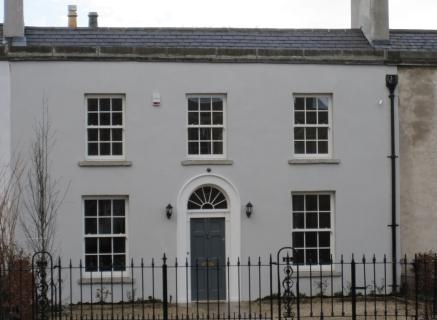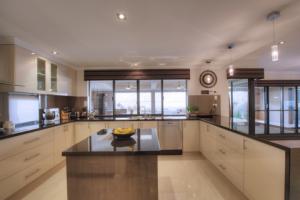Home and Garden Advice From The Experts
Bathroom, Shower and Wetroom Leaks - Advice from an Expert
pickapro
I've talked to Darren Kearns from Tilecraft, a Dublin specialist in bathroom renovations and leak repair about the topic of leaks. He explains why your bathroom and shower may be leaking and what your best course of action should be.
I've talked to Darren Kearns from Tilecraft, a Dublin specialist in bathroom renovations and leak repair about the topic of leaks. He explains why your bathroom and shower ...Extensions...Advice and Ideas From A Structural Engineer
pickapro
A successful extension can greatly improve a property in many ways. However there are risks to be addressed in the process. Structural engineer, Michael Hogan of Hogan & Associates has over 25 years experience in home and commercial building projects. We ask him to give us some advice and also some ideas. Learn about extending upstairs, and also about getting that perfect, "beam free" extension... A successful extension can greatly improve a property in many ways. However there are risks to be addressed in the process. Structural engineer, Michael Hogan of Hogan & Associates ...Paving For Driveways, Paths, Patios and Carparks
pickapro
As every estate agent will tell you, your front driveway sets the tone to your house. It might also dictate whether you can park comfortably outside your house - or whether you squeeze out the door and then step right into a nice puddle or mucky bit of grass! If you've been thinking about tackling it, well read on. We've asked our professional pavers on pickapro.ie for some inside knowledge on driveways and patios. As every estate agent will tell you, your front driveway sets the tone to your house. It might also dictate whether you can park comfortably outside your house - or whether you ...Furniture Makeover With The Upholstery Experts
pickapro
Lumpy couches, wobbly chairs, scratched leather and dated colour schemes - it's all in a day's work for the team at Portmarnock Furnishings Ltd. We've presented our experts with 6 furniture issues to tackle. Read how your furniture can get a whole new wow factor, often for a fraction of the cost of replacing with new.
Lumpy couches, wobbly chairs, scratched leather and dated colour schemes - it's all in a day's work for the team at Portmarnock Furnishings Ltd. We've presented our experts with ...Bathroom Renovations - Ideas from the Experts
pickapro
pickapro have talked to Rachael and Shane from Tile Rooms, bathroom and tiling specialists with showrooms in Newlands Retail Centre, Dublin 22. They gave us lots of interesting ideas but no rules! Their approach is firmly that it's all about getting what's right for you.
pickapro have talked to Rachael and Shane from Tile Rooms, bathroom and tiling specialists with showrooms in Newlands Retail Centre, Dublin 22. They gave us lots of interesting ...10 Great Interior Design Tips
pickapro
Decorating a room or home can be an expensive business! Small wonder that so many of us play it safe with neutral colours. Perfectly fine, but maybe not exactly what we wanted. So, we've summoned the help of an experienced Dublin interior designer to give us a little courage for the trip. Decorating a room or home can be an expensive business! Small wonder that so many of us play it safe with neutral colours. Perfectly fine, but maybe not exactly what we wanted. ...Timber Flooring Essentials
pickapro
A wooden floor must be one of the best home improvements any home owner can make. Yes, it adds immensely to the value of the house, but that's not the biggest benefit. They just look and feel so good. A timber floor is always stylish, and with a couple of rugs over it, is also incredibly cosy. Because of the range of colours in wood from purple to red to browns, timber will match just about every colour scheme. It's easy to clean, doesn't collect dust, and will probably outlast you. A wooden floor must be one of the best home improvements any home owner can make. Yes, it adds immensely to the value of the house, but that's not the biggest benefit. They just ...Building A Sunroom Or Conservatory
pickapro
We don't get too many sunny days in Ireland, so it goes without saying that you don't want to miss the sun when it does shine. We have asked our experts for some advice on adding a sunroom or conservatory to your house. We don't get too many sunny days in Ireland, so it goes without saying that you don't want to miss the sun when it does shine. We have asked our experts for some advice on adding ...Attic Conversions
pickapro
If you'd like some additional space, attic conversions are a great option. The beauty of attic conversions is that you are converting "dead space" without any impact on your garden or the rest of your house and at a lower cost than an extension. If you'd like some additional space, attic conversions are a great option. The beauty of attic conversions is that you are converting "dead space" without any impact on your garden ...Preparing Your Garden For Winter
pickapro
Some people believe that when the weather starts getting colder and the fallen leafs have been raked up, it's time to put away the gardening tools and wait until next spring to work on their garden again. Wrong! Winter may seem like the end of the road for awhile, but there are a few things left to do to protect your garden during the harsh months ahead and prepare it for the following spring. So before you go inside and shut the door on your garden for the season,make sure you or an experienced landscaping company puts your garden to bed. A little preparation can make a huge difference to your garden in the spring. Some people believe that when the weather starts getting colder and the fallen leafs have been raked up, it's time to put away the gardening tools and wait until next spring to ...Smart Tiling Tips
pickapro
If you're thinking about tiles for a new house or simply giving the old tiles in your house the occasional evil eye, then you're at the right place. We've asked our expert tilers to give us their tips. If you're thinking about tiles for a new house or simply giving the old tiles in your house the occasional evil eye, then you're at the right place. We've asked our expert tilers ...Building An Extension In Ireland
pickapro
They say space is the final frontier. Well, it is for many Irish homeowners anyway. For many of us, the solution lies in extending what we have. So, we've asked experienced Dublin builders from pickapro.ie to give us the scoop on planning and building a house extension. They say space is the final frontier. Well, it is for many Irish homeowners anyway. For many of us, the solution lies in extending what we have. So, we've asked experienced Dublin ...The Things Which Are Surprisingly Bad For Your House and Garden
pickapro
I wanted to find out what gets our home and garden professionals shaking their heads. I put it to them and got back a fantastically diverse set of answers. From structural engineers, to interior designers to landscapers, a lot of them had their say. I have to say, I'm guilty of at least one of these things myself... I wanted to find out what gets our home and garden professionals shaking their heads. I put it to them and got back a fantastically diverse set of answers. From structural engineers, ...Dog Friendly Garden Ideas for Dogs That Dig
pickapro
Geraldine contacted us with her problem - her dog and her garden are at odds. She tried to go for a low maintenance garden, but the dog keeps pulling up the black weed cover. She would also like to do something about an old concrete dog run on the side of the garden which is looking "a little worse for wear" Geraldine contacted us with her problem - her dog and her garden are at odds. She tried to go for a low maintenance garden, but the dog keeps pulling up the black weed cover. She ...Choosing The Right Contractor
pickapro
Choosing the right contractor is the most important factor in determining the success or failure of your home or garden improvement project. At Pickapro.ie we've interviewed hundreds of Dubliners about their experience in choosing a home improvement professional. Here are some of the tips that we've picked up from homeowners who have made a successful match. Choosing the right contractor is the most important factor in determining the success or failure of your home or garden improvement project. At Pickapro.ie we've interviewed hundreds ...Condensing Boilers Cut The Cost!
pickapro
Replacing a 15 year boiler with a new high efficiency condensing boiler could represent a fuel saving of more than 25%. So if you annual oil fills typically cost €1,000, you're looking at a saving of €250 per year. Remember that there's SEI grants too. Interesting? Find out more from our boiler experts... Replacing a 15 year boiler with a new high efficiency condensing boiler could represent a fuel saving of more than 25%. So if you annual oil fills typically cost €1,000, you're ...Plumbers Tips For Energy Efficiency
pickapro
There's a lot of us living with the joys and challenges of old fashioned plumbing. It's probably functional but it certainly isn't efficient. With fuel and oil costing plenty and new grants now available from Sustainable Energy Ireland to upgrade the efficiency of your home, it's worth looking at what can be done to upgrade the heating system in an older house. We asked several experienced plumbers what plumbing upgrades will give the best bang for your buck. There's a lot of us living with the joys and challenges of old fashioned plumbing. It's probably functional but it certainly isn't efficient. With fuel and oil costing plenty and ...Roof Maintenance
pickapro
One of the most common, costly and often times ignored household maintenance projects is the roof over your head. Unless you've had water dripping on your head, it's easy to put it on the back burner until it comes up and really take a bite out of you and your bank balance. Read our quick guide to preventative maintenance for roofs to find out what you need to protect your roof and house. One of the most common, costly and often times ignored household maintenance projects is the roof over your head. Unless you've had water dripping on your head, it's easy to put ...Sell Your House For More
pickapro
Decorating your house to sell is a completely different proposition from interior design for living. We've asked the professionals to tell us how to turn your property into a "must have" for buyers without breaking the bank. Decorating your house to sell is a completely different proposition from interior design for living. We've asked the professionals to tell us how to turn your property into a "must ...Great Gardens For Children and Adults
pickapro
Do houses actually shrink over the Winter or does it just feel that way? There is of course a fantastic relief valve, more commonly known as the garden but it's often neglected at this time of the year. Like adults, children aren't enticed by a muddy strip of lawn and some drippy brown trees. So we've asked experienced Dublin landscapers from pickapro.ie to give us some inspiration for a garden that will appeal to both children and adults year round. Do houses actually shrink over the Winter or does it just feel that way? There is of course a fantastic relief valve, more commonly known as the garden but it's often neglected ...Decks For Irish Gardens
pickapro
There's something intrinsically enjoyable about sitting on a wooden deck. It's back to nature - like a tree house for adults! www.pickapro.ie, the website of home and garden professionals have asked the professionals for advice on building the perfect deck. There's something intrinsically enjoyable about sitting on a wooden deck. It's back to nature - like a tree house for adults! www.pickapro.ie, the website of home and garden professionals ...Ground Cover Basics
pickapro
When it comes to gardens, an important element of the foundation, is what's literally underneath your feet - ground cover including soil, grass, bark, chippings and stone. We've asked landscaping supplies specialists to give us practical advice on buying these very important basics. When it comes to gardens, an important element of the foundation, is what's literally underneath your feet - ground cover including soil, grass, bark, chippings and stone. We've ...Garden Design Ideas
pickapro
With the garden being the top priority for 2007 according to our survey, we talked to landscaper Dermot Strong about tips for homeowners planning to improve their garden this year. With the garden being the top priority for 2007 according to our survey, we talked to landscaper Dermot Strong about tips for homeowners planning to improve their garden ...Soundproofing Your Home
pickapro
With more and more Irish people living in high density apartments and houses, many of us are be feeling the pain of thin party walls. The long term solution may be higher standards in building but that won't help us now. Find out more sound proofing and how it can drastically improve your quality of life. With more and more Irish people living in high density apartments and houses, many of us are be feeling the pain of thin party walls. The long term solution may be higher standards ...Sustainable Designs Reduces Running Costs
pickapro
How can you use sustainable design in your home to reduce energy costs Architect, Simon Hoe RIBA explains how. How can you use sustainable design in your home to reduce energy costs Architect, Simon Hoe RIBA explains how.Awake To Bird Song In Your Garden
pickapro
Most of us don't know our blue tits from our chaffinches, but we still stop to watch the antics of our local friendly wildlife. They add colour and endless fascination to our gardens. pickapro.ie finds out how to entice birds into our gardens. Most of us don't know our blue tits from our chaffinches, but we still stop to watch the antics of our local friendly wildlife. They add colour and endless fascination to our gardens. ...How To Choose A Landscaper
pickapro
Dublin landscapers give us the benefit of their landscaping experience. How to choose a landscaper? Is there a best time of year to hire a landscaping company in Dublin? What's popular in Dublin gardens now? And there's the all important top landscaping tips. Dublin landscapers give us the benefit of their landscaping experience. How to choose a landscaper? Is there a best time of year to hire a landscaping company in Dublin? What's ...How To Choose A Garden Designer
pickapro
We've asked our pickapro garden designers to talk to us about garden design. First of all, why is a design useful? Next - how to choose a garden designer. What are the right questions to ask a prospective designer? How much do garden designs cost? What questions will the designer ask? What information should the homeowner provide? What happens after the design process? What are their personal design likes and dislikes And finally, their top garden design tips
We've asked our pickapro garden designers to talk to us about garden design. First of all, why is a design useful? Next - how to choose a garden designer. What are the right questions ...


